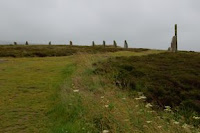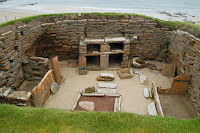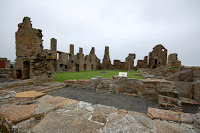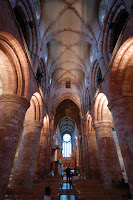Wednesday, July 11, 2007 – Kirkwall (Orkney Islands), Scotland
We anchored off of the coast of Kirkwall by 7am, but since we’d planned to tour the island on our own, rather than take a ship’s tour, we had time for a leisurely sit-down breakfast in the DaVinci Diningroom. NOTE: I’m happy to report that the staff at the DaVinci Diningroom was always friendly and attentive throughout the cruise.
Afterwards, we boarded a tender for the short but bumpy tender ride into Kirkwall. The driver of our tender was an amiable fellow, laughing the entire time that he was knocking the tender against the dock, trying to straighten it out enough to be secured by the land crew. At least we knew the tenders were sturdy!
We were told that the taxis would be scarce at the dock area, but when we got there we saw a line of them waiting. Rich spotted a large taxi van in the line and made a beeline for it. Luckily, we were able to hire the 7-seater “people mover” to take us around (Craigies Taxi, phone#01856 878787) for £45 an hour (expect to pay less for a smaller taxi). We told our driver, Ian, that we wanted to spend about 2 hours touring, and would most like to see Skara Brae, the Ring of Brogar, and St. Magnus Cathedral, with some venturing through the unspoiled countryside that Kirkwall is known for.
NOTE: You may see the Ring of Brogar referred to as the Ring of “Brogdar”, particularly in older guidebooks or on the Princess Port Guide literature. Both spellings have been used in the past and both are technically correct, but in 2003, the folks at Historic Scotland (the Tourism officials) decided to revert to the Orcadian spelling, which is Brogar. So, for the purposes of this blog, that’s what I’ll use.
We were also looking forward to seeing the local countryside and hopefully some of the wildlife that was there for mating season. We’d really hoped to see mating pairs of Puffins along the shore, but our driver warned that it was a bit late in the summer for that, and that most had left already. Still, we hoped to get lucky.
Our driver was wonderful: very friendly, and great with the kids. He told us that if we saw anyplace we wanted to stop (such as the various crafts shops off of country lanes or farmstands), we could just speak up and he’d pull over. We’d hoped to avoid the crowds, so our first stop was the Ring of Brogar. Good move going there first: it was empty!
Perhaps not as well known as Stonehenge, but just as impressive, the Ring of Brogar is an ancient stone circle that is purported to possess special powers. Used in seasonal gatherings thousands of years ago, about half of the stones marking this site are still standing in their original positions. Unlike Stonehenge, which is roped off and protected, visitors have full access to the stones at Brogar. You can walk right up and touch the monolithic stones, weaving among them and feeling the eerie, hallowed echoes of mystical ceremonies past.
NOTE FOR THOSE WITH MOBILITY ISSUES: There is a bit of a walk over grassy areas from the parking area to the Ring. There are walkways with a rubber underlayment to make the way smoother, but it can still be uneven in places. Take your time and walk with care: the stones have been there for thousands of years, they’ll wait for you!
It was very windy, cold, and blustery out there by the Ring, and once the tour buses started to show up, we made our back to our taxi and continued on to Skara Brae.
The story of Skara Brae’s discovery is almost as remarkable as the ancient village itself. Built more than 5,000 years ago, the village was buried under layers of sand and silt, until a strong storm blew through the area in the mid-1800’s, revealing the preserved houses below. The landowner who lived here allowed excavators to come in and uncover this amazing discovery: an ingenious network of tunnels made from stacked stones, leading from one home to another. Visitors can walk through a reconstruction of House #7 and see what these dwellings might have looked like when they were inhabited. There’s a bit of a walk to get from the visitor center over to Skara Brae, but you can pass the time by reading the stone markers as they count backwards from present day time, through the birth of Christ, the building of the Great Wall of China, back further to the time of the Great Pyramids, and then finally, 5000 years back, to when Skara Brae was constructed.
Once at the site, you walk along a series of raised platforms that allow visitors to peer down into the homes, which have been remarkably preserved through time and are surprisingly intact. There are informational markers along the way, so you know a little bit of the history behind what you’re looking at, and the views of the sea are breathtaking from that vantage point. Yes, it’s a bit windy, but bundle up and take some time to marvel at this astonishing glimpse into human history.
If you wish, you can also visit the 400-year-old Skaill House, the manor house on the grounds where Skara Brae was discovered. A tour of the manor is included in the price of admission for Skara Brae, but we opted to skip it so that we could see more of the island itself.
After a quick stop in the bathrooms (not great, but serviceable), we made our way back to the taxi, to take a drive through the countryside of this beautiful area and head back to Kirkwall. While he was waiting for us, our driver Ian chatted with the guides at Brogar, and they mentioned a spot where Puffins had been seen a few days prior. So, Ian took us there—to the Brough of Birsay—in the hopes that we’d see them. Unfortunately, the puffins had already made their way back out to sea, but the seaside views were incredible, and we did spy some beautiful local species of sea bird.
During our drive through the picturesque countryside, we chatted with Ian about Orkney and the local economy there. He mentioned that the island does not import any beef; it has so much cattle, the industry is self-sustaining. Orkney Beef, he told us, was of the very finest quality, because the free-range cattle are raised on an organic, natural diet of grasses. He said that you haven’t tasted real beef until you’ve tried Orkney’s beef—it’s that tasty. Hmmm…Rich and I looked at each other, and made a mental note to do our best to sample some before we left the island.
We made a brief visit to the ruins that were once the Earl’s Palace at Birsay, and since the 7-year-old needed to use the restroom again, it was a welcome stop. (Not exactly luxurious, but surprisingly clean for what was basically a glorified port-a-potty.)
Afterwards, Ian dropped us off at St. Magnus Cathedral, where we toured this serenely beautiful church and admired its architecture and inlayed floors. Built in 1137, the Cathedral is a blend of Romanesque and Gothic building styles. The church has been renovated and expanded over the years, but retains its historic appeal.
We walked through Kirkwall to do a bit of souvenir shopping and find a place for lunch. Many of the shops had beautiful woolen items, but the prices were the highest we’d seen thus far. We finally ducked into a little touristy shop and I let the two younger girls pick up a stuffed puffin and a puffin puppet—they didn’t get to see the real thing, but this was a good consolation prize. The teenager didn’t see anything that struck her fancy, until we reached a small shop that had dozens of colorful yarn skeins displayed in the window. Christina recently learned how to knit, and I taught her how to crochet years ago, so she decided the perfect souvenir would be some Orkney Wool.
The shop (Orcadian Crafts, 8 Bridge Street) was a zoo—packed with people, elbow-to-elbow, sifting through the moderately-priced “made in China” souvenirs items amidst the genuine tartans and wool sweaters. As we waited on the long line, we perused the stacks of yarn behind the counter, trying to choose what colors we wanted. It was then that I read the print on the sign: 80% acrylic, 20% wool. What the? ACRYLIC???
When we got to the register, I asked the guy if he had any wool that was specifically from Orkney itself. That was when he reached under the counter and pulled out the most gorgeous spool of natural, cream-colored wool. “This is spun right here in Orkney. 100% wool.” Perfect! Like an idiot, I asked, “Does it come in any other colors?” and he looked at me like the stupid city-girl I am and said, “No, this isn’t dyed or processed, you see.” Duh…of course….it was cream colored because THAT’S WHAT COLOR SHEEP ARE. I said, “We’ll take it” just as he said, “Oh, wait a second…” and reached under the counter again, shuffling things around and finally coming up with another spool in his hand, saying, “Ah, here, we have this, too.”
It was another spool of local Orkney wool, only this one had threads of black running through it—spun from the fleece of the two-tone and black sheep. I nearly died and went to heaven, I was so excited.
We bought 200grams (£6 per 100 grams) of each, and Christina plans to knit a 100% wool scarf for herself, with a matching purse, if there’s enough wool. It was, by far, my favorite souvenir we’d purchased this trip.
We tried to find a restaurant along the main strip, but everywhere we looked, we saw only bakeries and small cafés—nothing that would provide a solid lunch to tide us over until late seating. We decided to head back to the ship early and eat there instead.
UNTIL…we got to the street just before the tenders, and I noticed a restaurant at the water’s edge, aptly named The Shore (www.theshore.co.uk). As we stood outside reading the menu, one of the priests we’d seen earlier in St. Magnus Cathedral walked by and said, “I love that place! I highly recommend it!!” Well, okay then! In we went.
One look at the menu, and we knew exactly what to order: Orkney Steak and Ale Pie, coming right up! In keeping with our quest to try the local spirits whenever possible, Rich ordered a Northern Lights Ale while I had the Skapa Special Ale—both were smooth and distinctive, a perfect accompaniment to the meal.
Unfortunately, there wasn’t much on the menu that appealed to the kids (they’d already had their hearts set on the Pizza by the pool area….oh well) so we let them order the Crepes with Orkney Vanilla Ice Cream and Orkney Strawberry Ice Cream. Both were rich and creamy and absolutely fabulous. (Did I mention Orkney is known for their superlative dairy, too?)
After a great meal (good lord, the beef was fabulous), we headed back to the ship on the next tender. Rich took the kids up for pizza, while I decided to try my luck in the Laundromat, while most passengers were still out on ship’s tours.
Sure enough, there were only a few people in the laundry room, and I had to wait just a few minutes for an available machine. While I was there, I made conversation with the other passengers, and was comforted to learn that they, too, were disillusioned with the behavior of some of the staff members on board. One woman was a Princess Cruises Elite Member, and she told me that “every ship has a personality,” and that she wasn’t pleased with the tone of the Grand Princess. Like me, she’d noticed the lack of helpfulness and experience in many of the crew, although she was enjoying her trip nonetheless, as was I.
I met another woman there from Georgia, a very nice gal who had cruised several times before, and was convinced that the problem on board was the elimination of individual tipping. Now that Princess charges every stateroom a flat fee for tips, which are shared amongst the crew, she believed there was no incentive for individual members to provide superlative service. Hmm…could be something to that.
She seemed like a very sweet and non-confrontational type of person, so it surprised me when she said that she had already stopped at the Purser’s Office and lowered the tip amount charged to her stateroom—something that all passengers have the option of doing, if they feel the service is not up to par. She said she felt strongly that a message needed to be sent. She was particularly unhappy with her room steward (he never refilled the toilet paper, and barely ever replaced the towels) and she refused to sit back and take it. That’s when yet another person in the laundry room also spoke up, and said that he, too, lowered the tip based upon the poor service he received, particularly from the Purser’s Desk. (He’d had trouble trying to get money converted, and had a bad experience with the staff when he tried to straighten it out.)
I mentioned all of this to Rich when I got back to the room, and he was horrified. He agreed that we’d seen some less-than-stellar service from the staff, but nothing that would cause him to lower their tips. He said that these crew members are not paid much, and that they count on their tips, and he wasn’t about to take it away from them. They showed up, they did their jobs, they deserved to be compensated. The other passengers, however, argued that one’s only recourse for poor service is to withhold or lower the tips, and that if you don’t, they’ll never have any incentive to improve. Strong arguments on both sides…I leave it up to you to decide the right course of action, based upon your own cruise experience. We kept the standard tip amount in place.
Another reason I’d made so many friends in the laundry room: I ended up sharing my laundry detergent with 4 other passengers, who were victims of the non-functioning vending machines. It pays to bring some detergent with you, just in case, and I was more than happy to help. It’s not only a nice gesture, it’s good karma, and a great way to meet people. After my jaunt in the laundry room, I had a whole other set of folks who waved and said hi as I walked ‘round the ship. Never underestimate the power of a good deed, even if it’s a small one.
We still had plenty of time before dinner, so we headed over to the Explorer’s Lounge for some Afternoon Team Trivia with Jason—a favorite activity for the kids.
After showers and dinner, everyone was beat, so we skipped the evening show and headed straight for bed, looking forward to our next port, where we’d booked a private tour of Inverness.
Coming up: Searching for the elusive Loch Ness monster. Here, Nessie…here girl!
all photos by RichYak copyright 2007




